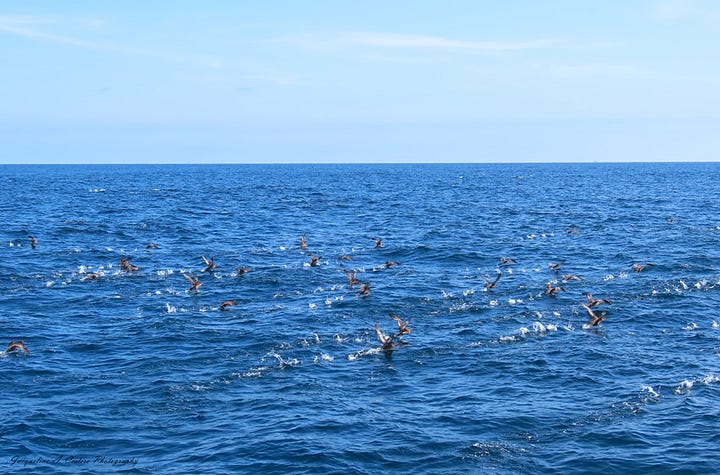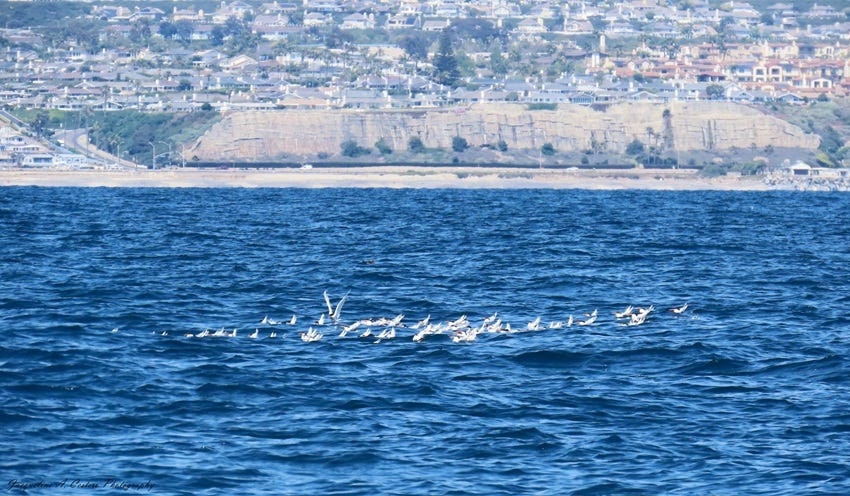As we headed north back to LA, we made a final stop at Dana Wharf Whale Watch. On the 2:30 excursion, we finally saw sunshine!
We headed in a different direction from the earlier trip. We later learned the Blue Whales had moved out of the range of the tour time.
On the way, a group of Royal Terns were seen feeding on the open water with Brown Pelicans.
Far in the distance, there were flashes of white seen on the water. The naturalist on board for the trip suspected they were dolphins.
Much to our delight, she was correct. The boat was amid a large group of Long-beaked Common Dolphins.
NOAA Fisheries gives a summary of the species as follows:
“Long-beaked common dolphins can be found in large social groups in the Atlantic, Indian, and Pacific Oceans. This highly social and energetic species prefers shallow, tropical, subtropical, and warmer temperate waters closer to the coast and on the continental shelf.
Long-beaked common dolphins are closely related to—and easily confused with—short-beaked common dolphins. Once thought to be a single species, the two species differ slightly in size, appearance and habitat preference. Long-beaked common dolphins are less abundant than their short-beaked relatives.
The eastern North Pacific long-beaked common dolphin, the only population found in the United States, is not listed as threatened or endangered. Like all marine mammals, they are protected under the Marine Mammal Protection Act.”
To the excitement of everyone onboard, these playful creatures were bow-running the boat with their youngsters. Some looked so small they might have been only days old.
This species measures up to 8 feet in length and can weigh as much as 500 pounds!
Further, NOAA tells us:
“Long-beaked common dolphins are usually found in large social groups averaging from 100 to 500 animals, and they are occasionally seen in larger herds of thousands of individuals. These large schools are thought to consist of smaller sub-groups of ten to 30 potentially related individuals or individuals of similar age and sex.
Long-beaked common dolphins are often active at the surface and display various behaviors. These highly social, energetic dolphins are commonly seen swimming rapidly and leaping out of the water at high speeds. They will also swim near the front of ships and ride the pressure waves (or bow-riding) for long periods of time.
Long-beaked common dolphins feed in relatively shallow waters on small schooling fish (e.g., anchovies, hake, pilchards, and sardines), krill, and cephalopods (e.g., squid). Dolphin groups may work together to herd schools of prey. Their diving behavior is thought to be like that of short-beaked common dolphins.”
As we left one group, we found hundreds of Sooty Shearwaters feeding along with another large school of Common Dolphin.


We saw one Minke Whale, but it was too fast to capture a photograph.
As we returned to port, the passageway was filled with seabirds and sea lions basking in the sun.
While we didn’t see the massive Blue Whale, we were lucky to spend a few hours with the playful dolphins and seabirds. It was an amazing nature-filled afternoon to wrap up the trip.
I hope you enjoy a few minutes of this experience in the companion video below!












It is so exciting being this close to nature. Look at those dolphins move! Thank you for sharing your day. Looked like it was so much fun.